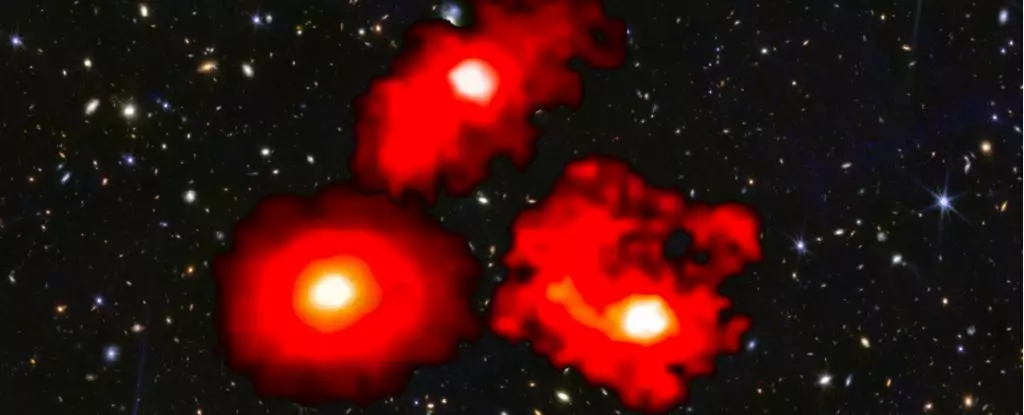In a remarkable discovery that has ignited considerable debate among cosmologists and astronomers, scientists have identified three significantly large galaxies dating back to the early Universe, during a time when such massive cosmic structures were believed to be highly improbable. Dubbed the ‘red monsters’ due to their size and properties, these galaxies appear to challenge established theories regarding galaxy formation and evolution. This article delves into the implications of these findings and the fundamental questions they raise about our understanding of the cosmos.
The large galaxies discovered exhibit characteristics that are almost comparable to the Milky Way, which poses a major challenge to existing models of galaxy formation. Ivo Labbé, an astronomer from Swinburne University of Technology, aptly likened the discovery to encountering a toddler weighing a staggering 100 kilograms. Such a phenomenon should not theoretically exist in the early Universe, which was still in its formative years post-Big Bang. This contrasting evidence ignites a fiery debate regarding the traditional understanding of matter accumulation and star formation in galaxies.
Observations made possible by the James Webb Space Telescope (JWST) permit astronomers to peek into the early cosmic environment like never before. By detecting wavelengths stretched by the expansion of the Universe, the JWST is uncovering insights into the Cosmic Dawn, a crucial era believed to last about a billion years after the Big Bang. However, despite our burgeoning knowledge of cosmic processes, this “dark age” of observational understanding remains riddled with uncertainties.
Previously accepted models suggested that galaxies develop incrementally over time from clumps of dark and baryonic matter. Typically, galaxies are thought to evolve slowly, coalescing heavy matter into stars that orbit supermassive black holes. However, the existence of these red monsters suggests that something extraordinary has transpired in the early Universe, where galaxies seem to form at an unprecedented pace, contradicting our established understanding.
The prevalent cosmological models forecast a gradual assembly of galaxies, yet their rapid emergence in observations contradicts expectations. The JWST observations yield evidence that select galaxies are vastly larger than predicted, igniting discussions that could recalibrate our notion of how galaxies interact and evolve across cosmic time. While some researchers previously posited that these galaxies might appear more massive due to the extreme luminosity of their central black holes, current findings indicate they truly possess greater infrastructure than initially believed.
The nature of star formation within these early galaxies presents an intriguing conundrum. The research spearheaded by astronomer Mengyuan Xiao from the University of Geneva indicates that these galaxies are forming stars at rates two to three times higher than some of contemporary galaxies. This implies a highly efficient mechanism for star formation is operational in the early Universe.
The findings pose numerous questions: how can early galaxies sustain such rapid star formation when traditional models suggest feedback mechanisms—like supernovae or radiation from black holes—that typically disrupt star formation? The very forces that might theoretically impede star creation are absent in these fierce cosmic environments, leading to a paradoxical state where star formation flourishes against the odds. Labbé underscores this dilemma, asserting that current models falter in accounting for the effusive star formation relatively unscathed by feedback from stellar explosions or black hole emissions.
With such surprising findings emerging from the JWST’s exploration, the astronomer community now faces the critical task of reconciling these revelations with existing models. The term “red monsters” may resonate for years, fostering both curiosity and concern as researchers grapple with the implications for dark matter theory and galaxy evolution paradigms.
As we delve deeper into the Cosmic Dawn, we are reminded of the complexities inherent in cosmological research. This period, once shrouded in mystery, is shaping up to be a significant arena for academic investigation, challenging prior assumptions about the Universe’s infancy. The discovery of these three massive galaxies might just be the tip of the iceberg, leading us to reconsider the fundamental tenets of galaxy formation and the Universe’s expansion.
The existence of these red monsters compels astronomers to re-examine their conceptual frameworks and theories. The answers gleaned from studying these ancient galaxies may redefine the trajectory of our cosmic understanding and illuminate new paths of inquiry for the future. Acknowledging these challenges not only enriches our exploration of the cosmos but also serves as a reminder of the boundaries of our current knowledge and the exciting possibilities that lie ahead.


Leave a Reply